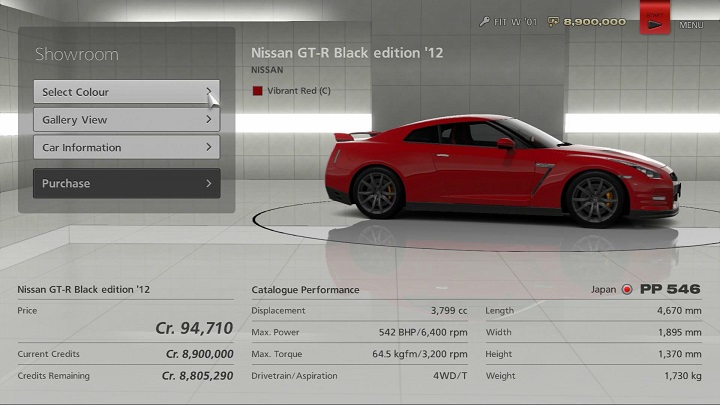Managing Your Cars
Viewing a Car's Catalogue Performance


If you're finding it hard to win races, you should try changing your car's settings by fitting new parts at the Tuning Shop. If you still can't win, you should consider switching to a faster car.
A car's catalogue performance is displayed in the bottom-right corner of the Dealership's Showroom screen. A car's catalogue performance contains the following information, which should give you a clue as to a car's capabilities:
- ・Displacement
- This figure indicates how much air and fuel is sucked into the engine, and is a guide to engine size. In general, the higher a car's displacement, the easier it is for the engine to produce power. You can increase output without changing the displacement, however, by fitting a turbo kit or supercharger.
- ・Max. Power
- This figure indicates an engine's performance level, and is a guide to how fast a car is. In general, the higher a car's max. power, the better its acceleration and top speed, though a car's weight and other factors may produce some exceptions to this rule.
- ・Max. Torque
- This figure indicates the amount of power produced by the engine, and is a guide to how fast a car is. In general, the higher a car's max. torque, the better its acceleration and top speed, though a car's weight and other factors may produce some exceptions to this rule.
- ・Drivetrain/Aspiration
- Indicates where a car's engine is located, and whether it powers the front or rear wheels. The various types of drivetrain are as follows:
- FF (Front Engine/Front-Wheel Drive): Both steering and transmission of engine power are done entirely through the front wheels. This kind of drivetrain places great stress on the front wheels, making it unsuitable for high-powered engines.
- FR (Front Engine/Rear-Wheel Drive): Steering is done through the front wheels, while engine power is transmitted through the rear wheels. This type of drivetrain provides excellent front-rear weight balance. It is relatively well-suited to high-powered engines, though once a certain limit is reached, traction control and other features become necessary.
- MR (Mid-Engine/Rear-Wheel Drive: The engine is located in the middle of the car's body, making this type of drivetrain excellent for cornering. It is relatively well-suited to high-powered engines, and is often used in racing cars.
- RR (Rear Engine/Rear-Wheel Drive): With this type of drivetrain, the engine is placed even farther back than the rear wheels which power the car. The rear wheels also bear the bulk of the car's weight, meaning that this drivetrain provides good acceleration. RR drivetrain cars do not turn very well, however, and it takes time to get used to their handling.
- 4WD (Four-Wheel Drive): The engine's power is transmitted through all four wheels. The amount of stress placed on each tyre is reduced, meaning that this type of drivetrain is well-suited to high-powered engines. In principle, 4WD cars tend not to turn well, though there are electronic devices available to overcome this particular flaw.
- "Aspiration" refers to the method through which an engine sucks in air. NA (naturally aspirated) engines use the negative pressure produced when the pistons come down to suck in air. This is the most common method. T (turbo) and SC (supercharged) engines use turbines or rotors to forcefully suck in air. Both the T and SC aspiration methods involve pushing compressed air through the engine. This burns more fuel and usually produces higher max. power and max. torque than an NA engine with the same displacement figure. EV indicates that the car's engine is aspirated using an electric motor.
- ・Length/Width/Height These figures provide a guide to a car's size and proportions. In general, tall cars and cars that are narrow in relation to their length tend not to be very good at cornering.
- ・Weight
- A figure which indicates a car's weight. In general, heavier cars have worse acceleration and cornering speeds.
As well as these catalogue performance figures, each car has a PP (Performance Points) figure. A car's PP is a guide to its performance level, and a high PP figure generally indicates a fast car. Be sure to compare PP if you're not sure which car to go for.

- © 2016 Sony Interactive Entertainment Inc. Developed by Polyphony Digital Inc.
Manufacturers, cars, names, brands and associated imagery featured in this game in some cases include trademarks and/or copyrighted materials of their respective owners. All rights reserved. Any depiction or recreation of real world locations, entities, businesses, or organizations is not intended to be or imply any sponsorship or endorsement of this game by such party or parties. "Gran Turismo" logos are registered trademarks or trademarks of Sony Interactive Entertainment Inc.
